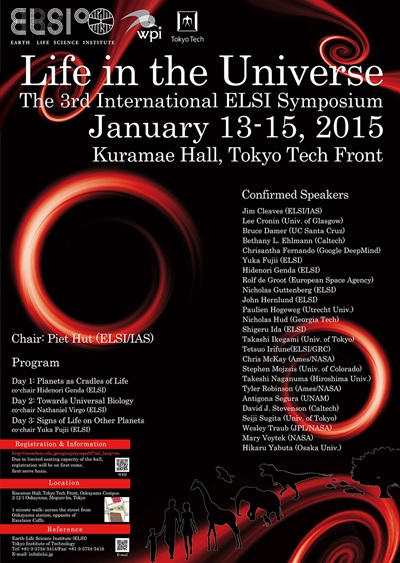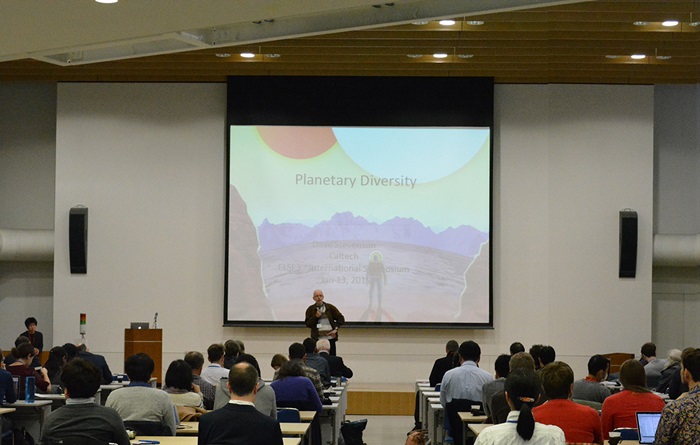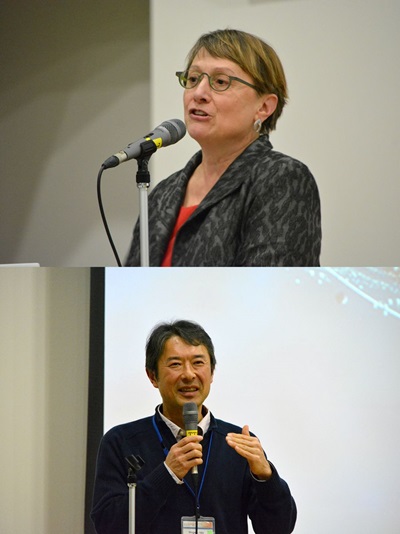Blog No.83
Author: Piet Hut

Last week ELSI held its 3rd annual international symposium, in Kuramae Hall, conveniently located right at the entrance of Tokyo Tech, a stone's throw from Ookayama station. The theme of the symposium was "Life in the Universe". Within that overall framework, there was a logical progression through three different themes on three consecutive days, starting from the structure and evolution of planets all the way to the how life could be detected on those planets. While I was the chair of the Scientific Organizing Committee for the symposium, much of the heavy lifting was done by the four co-chairs in the SOC, Yuka Fujii, Hidenori Genda, Jun Kimura, and Nathaniel Virgo, each of whom took care of a significant chunk of the meeting.
The first day's theme was "Planets as Cradles of Life," and was organized by co-chair Hidenori Genda. A rich set of talks exposed us to the amazing variety of planets in our solar system, with no two planets or moons being even remotely alike. The speakers focused especially on the early evolution of the planets and moons, and the possibility that they may have enabled life to exist. Forms of life may have either originated at the surface or below the surface, for example in subsurface oceans. And such life forms may either still be extant or if not, remnants may still be around to testify about the presence of past life. Especially impressive was the rapid progress reported about our knowledge of the state of the Earth in its Hadean and early Archean periods, during which life as we know it must have formed. Whatever we may learn in laboratories about possible ways that life might have formed in principle, unless we can use direct geophysical evidence about the condition of the early Earth, it would be hard to know how relevant such lab discoveries might be for the actual history of life on Earth.

While on the first day we heard where life might have possibly originated, on Earth as well as on other planets or moons, the second day followed with discussions about the kind of life that could have appeared on other bodies than the Earth, and perhaps even on Earth itself in the form of a `shadow biosphere' that we may one day discover. The theme was "Towards Universal Biology," while the day's sessions were organized by co-chair Nathaniel Virgo. This second day was spectacularly diverse. Some of the talks were more experimental, addressing the search for possible pathways for life to have evolved before RNA and DNA came into play, and illustrating the way chemical evolution may have gradually led to biological evolution as we know it now. Other talks were more theoretical, some focusing on the role that information plays in the origin of biological systems, others on the notion of open-ended evolution, and how to design and analyze abstract models of such general forms of evolution.
The third day brought the explorations of the first two days to a potentially testable status in the form of future observations. From the `where' of the first day, to the `how and what' of life's origins on the second day, the third day saw many fascinating talks about the `when' of observing traces of life. The theme was "Signs of Life on Other Planets", with Yuka Fujii as the co-chair responsible for the sessions. We heard about the ongoing search for life on Mars, past or perhaps even present, conducted by a large number of orbiters and landers, and to be followed up by daring new missions, including plans for sample return to Earth. Other talks covered various icy moons in our solar system, and the startling diversity among the thousands of exoplanets that have already been found. The fact that we are now beginning to be able to observationally address the presence of clouds on planets around other stars, while no such planet had been detected only a quarter century ago, is testimony to the unprecendented rate of discovery in astrophysics.
Each day also saw a different set of posters being exhibited, on the theme of that day. Co-chair Jun Kimura did a great job in organizing the poster sessions, and the one-minute flash talks with one slide per poster to give an overview of the session. The popularity of the poster sessions was no doubt caused by the many interesting pieces of research displayed, together with the possibility to talk directly with the presenters during the hour and a bit allocated to the freewheeling mingling in the poster room, and last but not least by the presence of free beer. :-) Each day would close with a one-hour panel discussion.
A special thanks is due here to the indefatigable efforts of the Local Organizing Committee, chaired by Alexis Gilbert. Other members were Jun Kimura, Hanako Ricciardi, Asako Sato, and Yu Yonehara. They were in large part responsible for the very smooth way the symposium operated, thanks to their hard work during the half year of intense preparation, partly visible, but largely hidden. Asako deserves notable mention for being the person behind all of the logistics of venue preparation, of travel arrangements for invited speakers and other visitors, of keeping us well-fed at the splendid banquet. In addition to the LOC, many other members of the ELSI staff helped prepare for the meeting, and handle the influx of the roughly hundred fifty participants to the symposium. One spectacular contribution was made by Akiyoshi Noda, ELSI master software wizard, who again showed his hardware talents as well in the construction from scratch of the `traffic light' pedestal that he created to keep all the speakers in line: two minutes before the end of each allotted talk time the light would jump from green to orange, followed by red when the speaker went overtime; a bit later the red light would start flashing, and that often was enough to convince the speaker to stop (there was a siren option built in too, but we decided not to use that :-).

In addition to the professional scientific parts of the symposium, the evening of the first day saw two very effective public talks, in the same large conference hall, which was packed to the rim with an audience composed of a wide variety, from eager high school students all the way to curious retired people living in the area. Given that the ELSI campus is embedded directly in a very typical Tokyo neighborhood, it was really nice to be able to show our neighbors some of what is going on every day in terms of research on the cosmos within shouting reach of their own homes. Mary Voytek, Director of the NASA Astrobiology program, took the audience on a breathtaking tour of the wild variety of life forms on Earth, many of which were not at all suspected to exist and were only discovered in the last couple decades. From there on, she moved through the solar system and beyond, pointing out in easy to understand terms what may lie waiting for us in discoveries to come. Shigeru Ida, a Vice Director of ELSI, followed by a detailed discussion of planet formation and possibilities for life to exist on planets near and far. In a daring and dazzling display of theories and observations he kept everybody at the edge of their seats. As was clear from the questions at the end of each talk, quite likely seeds were planted among the high school students for future careers in astrobiology and other topics studied in ELSI, from the formation of Earth and other planets to the origins of life.
